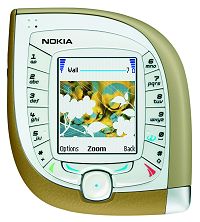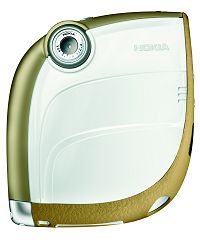Nokia 7600
The Nokia 7600 certainly doesn't look
much like a traditional handset on the outside,
and doesn't really act like a traditional
handset on the inside.
The most striking thing about the Nokia
7600 is the unusual format. Nokia have tried
to break away from the traditional rectangular
look to come up with something very different.
In this respect the Nokia 7600 is roughly
square in shape, measuring 87mm x 78mm x
18.6mm, or in other words, somewhat smaller
in footprint than a 3.5 inch floppy disk
and about as deep as a 5 pence piece is
wide. This makes the Nokia 7600 an interesting
"shirt pocket" format, although
at 123 grams it's about 25% heavier than,
say, the Nokia
7250i and about the same as the Nokia
6800.
Nokia aren't the first to experiment
with unusual phone configurations. The Siemens
Xelibri range demonstrates some highly
unusual handset designs, but none is as
feature packed as the Nokia 7600.
 The
buttons on the Nokia 7600 are arranged on
either side of a 128x160 pixel 65,000 colour
display, making it easy to use the buttons
while grasping the phone. The display is
interesting in itself, as it is 25% larger
than that on most standard current Nokia
models. This format is new to Nokia, but
the Siemens
SX1 offers a similar keypad arrangement
on a more conventional looking handset.
Both handsets are available at roughly the
same time. The
buttons on the Nokia 7600 are arranged on
either side of a 128x160 pixel 65,000 colour
display, making it easy to use the buttons
while grasping the phone. The display is
interesting in itself, as it is 25% larger
than that on most standard current Nokia
models. This format is new to Nokia, but
the Siemens
SX1 offers a similar keypad arrangement
on a more conventional looking handset.
Both handsets are available at roughly the
same time.
From a technical perspective, the Nokia
7600 is pretty interesting too. Firstly,
it can be used on both standard GSM networks
and also newer 3G networks. Unlike many
3G
phones, the Nokia 7600 isn't crippled
while on a GSM network, it's basically just
slower, although GPRS support on GSM means
that the data rate is up to a fairly reasonable
57.6kbps.
 Take
a look at the back of the Nokia 7600 and
you'll see the now common digital camera
lens poking out at you. This is a 640x480
pixel resolution camera (i.e. VGA resolution),
making it fairly good for small snapshots.
It can also capture video sequences. Although
Nokia are pushing the 7600 for its picture
capabilities, it's not as good as the camera
on the Sharp GX20
(which is also 640x480 but has a macro lens
and a flash). 29Mb of memory leaves plenty
of space for pictures. Take
a look at the back of the Nokia 7600 and
you'll see the now common digital camera
lens poking out at you. This is a 640x480
pixel resolution camera (i.e. VGA resolution),
making it fairly good for small snapshots.
It can also capture video sequences. Although
Nokia are pushing the 7600 for its picture
capabilities, it's not as good as the camera
on the Sharp GX20
(which is also 640x480 but has a macro lens
and a flash). 29Mb of memory leaves plenty
of space for pictures.
The Nokia 7600 plays MP3s too, but the
29Mb of memory presents a problem here.
A general rule of thumb is that an
entire CD fits onto about 64Mb if encoded
as a high-quality MP3, so the 29Mb will
fit less than half a CD, or else the quality
has to be dropped down to cope. Really the
minimum memory for an MP3 player should
be 128Mb. However, the Nokia 7600's 29Mb
is a lot compared to most phones on the
market, but don't throw away your MP3 player
just yet.
Other features include polyphonic ring
tones; voice dialling; infra-red, Bluetooth
and USB connectivity; voice recorder; email;
MMS and Java application support.
A potential weak area with the Nokia
7600 is battery life. With the standard
battery, the talktime on a 3G network is
between 1.8 to 2.9 hours, on GSM 3 to 4
hours.. so this phone is mainly aimed at
the occasional user rather than someone
who is glued to their mobile all day. Standby
time is a more respectable 7 to 12 days,
but its clear that the Nokia 7600 is limited
in this respect.
All-in-all, the Nokia 7600 is an innovative
package including many features not commonly
seen before. The unusual physical format
and attractive looks will appeal to many,
the good technical specification to others.
Maybe the Nokia 7600 isn't the groundbreaking
phone that Nokia would like to suggest,
but it will certainly influence the next
generation of mobiles.
|

![]()
![]()